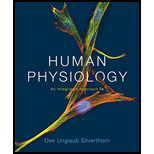
EBK HUMAN PHYSIOLOGY
7th Edition
ISBN: 9780133983401
Author: Silverthorn
Publisher: YUZU
expand_more
expand_more
format_list_bulleted
Question
Chapter 2, Problem 8CRQ
Summary Introduction
Introduction: Magnesium is an element with atomic number 12 in the periodic table. It consists of 12 protons and 12 electrons. It is represented by the chemical symbol Mg. It is considered as the ninth most abundantly found element in the universe. It is found in the human body where it is involved in maintaining the normal nerve and muscle function. It aids in the production of energy and also supports in keeping the immune system healthy.
Expert Solution & Answer
Want to see the full answer?
Check out a sample textbook solution
Students have asked these similar questions
glg 112 mid unit assignment Identifying melting processes
Give only the mode of inheritance consistent with all three pedigrees and only two reasons that support this, nothing more, (it shouldn't take too long)
O
Chapter 2 Solutions
EBK HUMAN PHYSIOLOGY
Ch. 2 - List three major essential elements found in the...Ch. 2 - What is the general formula of a carbohydrate?Ch. 2 - Prob. 3CCCh. 2 - Prob. 4CCCh. 2 - Prob. 5CCCh. 2 - Prob. 6CCCh. 2 - Which dissolve more easily in water, polar...Ch. 2 - Prob. 8CCCh. 2 - Why does table salt (NaCl) dissolve in water?Ch. 2 - Prob. 10CC
Ch. 2 - pH is an expression of the concentration of what...Ch. 2 - Prob. 12CCCh. 2 - Prob. 13CCCh. 2 - Prob. 14CCCh. 2 - Match each chemical to its action(s).Ch. 2 - What happens to the rate of an enzymatic reaction...Ch. 2 - What happens to the rate of an enzymatic reaction...Ch. 2 - Prob. 1CRQCh. 2 - Prob. 2CRQCh. 2 - Prob. 3CRQCh. 2 - Prob. 4CRQCh. 2 - Name the element associated with each of these...Ch. 2 - Write the one- or two-letter symbol for each of...Ch. 2 - Prob. 7CRQCh. 2 - Prob. 8CRQCh. 2 - H+ is also called a proton. Why is it given that...Ch. 2 - Prob. 10CRQCh. 2 - Prob. 11CRQCh. 2 - Prob. 12CRQCh. 2 - Prob. 13CRQCh. 2 - Prob. 14CRQCh. 2 - Prob. 15CRQCh. 2 - What aspect of protein structure allows proteins...Ch. 2 - Prob. 17CRQCh. 2 - List the three components of a nucleotide.Ch. 2 - Compare the structure of DNA with that of RNA.Ch. 2 - Distinguish between purines and pyrimidines.Ch. 2 - Prob. 1RQCh. 2 - Prob. 2RQCh. 2 - Prob. 3RQCh. 2 - Prob. 4RQCh. 2 - Fill in the blanks with the correct bond type. In...Ch. 2 - Prob. 6RQCh. 2 - Prob. 7RQCh. 2 - Prob. 8RQCh. 2 - Prob. 9RQCh. 2 - Prob. 10RQCh. 2 - Prob. 11RQCh. 2 - A molecule that binds to another molecule is...Ch. 2 - Prob. 13RQCh. 2 - Prob. 14RQCh. 2 - Prob. 15RQCh. 2 - Prob. 16RQCh. 2 - A solution in which [H+] = 103 M is...Ch. 2 - Prob. 18RQCh. 2 - Prob. 19RQCh. 2 - Prob. 20RQCh. 2 - Prob. 21RQCh. 2 - Prob. 22RQCh. 2 - Prob. 23RQCh. 2 - Prob. 24RQCh. 2 - Prob. 25RQCh. 2 - The graph shown below represents the binding of...
Knowledge Booster
Learn more about
Need a deep-dive on the concept behind this application? Look no further. Learn more about this topic, biology and related others by exploring similar questions and additional content below.Similar questions
- Describe the principle of homeostasis.arrow_forwardExplain how the hormones of the glands listed below travel around the body to target organs and tissues : Pituitary gland Hypothalamus Thyroid Parathyroid Adrenal Pineal Pancreas(islets of langerhans) Gonads (testes and ovaries) Placentaarrow_forwardWhat are the functions of the hormones produced in the glands listed below: Pituitary gland Hypothalamus Thyroid Parathyroid Adrenal Pineal Pancreas(islets of langerhans) Gonads (testes and ovaries) Placentaarrow_forward
- Describe the hormones produced in the glands listed below: Pituitary gland Hypothalamus Thyroid Parathyroid Adrenal Pineal Pancreas(islets of langerhans) Gonads (testes and ovaries) Placentaarrow_forwardPlease help me calculate drug dosage from the following information: Patient weight: 35 pounds, so 15.9 kilograms (got this by dividing 35 pounds by 2.2 kilograms) Drug dose: 0.05mg/kg Drug concentration: 2mg/mLarrow_forwardA 25-year-old woman presents to the emergency department with a 2-day history of fever, chills, severe headache, and confusion. She recently returned from a trip to sub-Saharan Africa, where she did not take malaria prophylaxis. On examination, she is febrile (39.8°C/103.6°F) and hypotensive. Laboratory studies reveal hemoglobin of 8.0 g/dL, platelet count of 50,000/μL, and evidence of hemoglobinuria. A peripheral blood smear shows ring forms and banana-shaped gametocytes. Which of the following Plasmodium species is most likely responsible for her severe symptoms? A. Plasmodium vivax B. Plasmodium ovale C. Plasmodium malariae D. Plasmodium falciparumarrow_forward
- please fill in missing parts , thank youarrow_forwardplease draw in the answers, thank youarrow_forwarda. On this first grid, assume that the DNA and RNA templates are read left to right. DNA DNA mRNA codon tRNA anticodon polypeptide _strand strand C с A T G A U G C A TRP b. Now do this AGAIN assuming that the DNA and RNA templates are read right to left. DNA DNA strand strand C mRNA codon tRNA anticodon polypeptide 0 A T G A U G с A TRParrow_forward
arrow_back_ios
SEE MORE QUESTIONS
arrow_forward_ios
Recommended textbooks for you

 Principles Of Radiographic Imaging: An Art And A ...Health & NutritionISBN:9781337711067Author:Richard R. Carlton, Arlene M. Adler, Vesna BalacPublisher:Cengage Learning
Principles Of Radiographic Imaging: An Art And A ...Health & NutritionISBN:9781337711067Author:Richard R. Carlton, Arlene M. Adler, Vesna BalacPublisher:Cengage Learning






Principles Of Radiographic Imaging: An Art And A ...
Health & Nutrition
ISBN:9781337711067
Author:Richard R. Carlton, Arlene M. Adler, Vesna Balac
Publisher:Cengage Learning
Haematology - Red Blood Cell Life Cycle; Author: Armando Hasudungan;https://www.youtube.com/watch?v=cATQFej6oAc;License: Standard youtube license